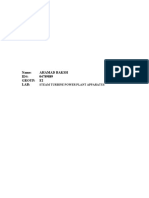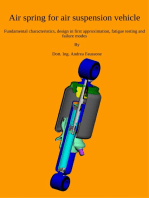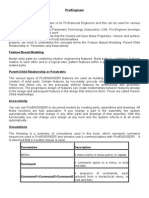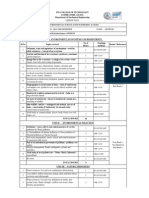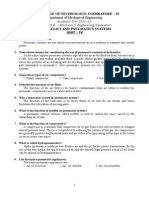0 ratings0% found this document useful (0 votes)
239 viewsTwo Mark Unit III
Two Mark Unit III
Uploaded by
hariharanbookNanofluids are engineered colloidal suspensions of nanoparticles in a base fluid. In
general the size of these nanoparticles vary from 1-100nm. The type of nanoparticle
used is directly dependent on the enhancement of a required property of the base
fluid.
All physical mechanisms have a critical length scale, below which the physical
properties of materials are changed. Therefore particles <100 nm exhibit properties
that are considerably different from those of conventional solids. The noble properties
of nanophase materials come from the relatively high surface area to volume ratio that
is due to the high proportion of constituent atoms residing at the grain boundaries.
The thermal, mechanical, optical, magnetic, and electrical properties of nanophase
materials are superior to those of conventional materials with coarse grain structures
[1].
Copyright:
© All Rights Reserved
Available Formats
Download as DOCX, PDF, TXT or read online from Scribd
Two Mark Unit III
Two Mark Unit III
Uploaded by
hariharanbook0 ratings0% found this document useful (0 votes)
239 views7 pagesNanofluids are engineered colloidal suspensions of nanoparticles in a base fluid. In
general the size of these nanoparticles vary from 1-100nm. The type of nanoparticle
used is directly dependent on the enhancement of a required property of the base
fluid.
All physical mechanisms have a critical length scale, below which the physical
properties of materials are changed. Therefore particles <100 nm exhibit properties
that are considerably different from those of conventional solids. The noble properties
of nanophase materials come from the relatively high surface area to volume ratio that
is due to the high proportion of constituent atoms residing at the grain boundaries.
The thermal, mechanical, optical, magnetic, and electrical properties of nanophase
materials are superior to those of conventional materials with coarse grain structures
[1].
Copyright
© © All Rights Reserved
Available Formats
DOCX, PDF, TXT or read online from Scribd
Share this document
Did you find this document useful?
Is this content inappropriate?
Nanofluids are engineered colloidal suspensions of nanoparticles in a base fluid. In
general the size of these nanoparticles vary from 1-100nm. The type of nanoparticle
used is directly dependent on the enhancement of a required property of the base
fluid.
All physical mechanisms have a critical length scale, below which the physical
properties of materials are changed. Therefore particles <100 nm exhibit properties
that are considerably different from those of conventional solids. The noble properties
of nanophase materials come from the relatively high surface area to volume ratio that
is due to the high proportion of constituent atoms residing at the grain boundaries.
The thermal, mechanical, optical, magnetic, and electrical properties of nanophase
materials are superior to those of conventional materials with coarse grain structures
[1].
Copyright:
© All Rights Reserved
Available Formats
Download as DOCX, PDF, TXT or read online from Scribd
Download as docx, pdf, or txt
0 ratings0% found this document useful (0 votes)
239 views7 pagesTwo Mark Unit III
Two Mark Unit III
Uploaded by
hariharanbookNanofluids are engineered colloidal suspensions of nanoparticles in a base fluid. In
general the size of these nanoparticles vary from 1-100nm. The type of nanoparticle
used is directly dependent on the enhancement of a required property of the base
fluid.
All physical mechanisms have a critical length scale, below which the physical
properties of materials are changed. Therefore particles <100 nm exhibit properties
that are considerably different from those of conventional solids. The noble properties
of nanophase materials come from the relatively high surface area to volume ratio that
is due to the high proportion of constituent atoms residing at the grain boundaries.
The thermal, mechanical, optical, magnetic, and electrical properties of nanophase
materials are superior to those of conventional materials with coarse grain structures
[1].
Copyright:
© All Rights Reserved
Available Formats
Download as DOCX, PDF, TXT or read online from Scribd
Download as docx, pdf, or txt
You are on page 1of 7
At a glance
Powered by AI
The key takeaways from the document are about different types of nozzles, nozzle efficiency, critical pressure ratio, super saturated flow, effects of super saturation, classification and comparison of steam turbines, compounding methods, and governing of turbines.
The various types of nozzles are convergent nozzle, divergent nozzle, and convergent-divergent nozzle. A convergent nozzle decreases in cross-section from entrance to exit, a divergent nozzle increases in cross-section, and a convergent-divergent nozzle first decreases then increases in cross-section.
There is only one value of the ratio of outlet to inlet pressure that produces maximum discharge from the nozzle. This ratio is called the critical pressure ratio.
Thermal engineering
Unit-3 [nozzles, turbine & steam power cycle]
Two mark question & answers
1 .what are the various types of nozzles and their functions?
a. Convergent nozzle: when the cross section of a nozzle
decreases continuously from entrance to exit, it is called a
convergent nozzle.
b. Divergent nozzle: when the cross section of a nozzle
increases continuously from entrance to exit, it is called a
divergent nozzle.
c. Convergent divergent nozzle: when the cross section of
the nozzle first decreases from its entrance to throat, and
then increases from its throat to exit, its called convergent
- divergent nozzle.
2 .Define nozzle efficiency?
The coefficient of nozzle or nozzle efficiency
(usually denoted by k) is defined by as the ratio of useful heat
drop to isentropic heat drop. Mathematically
K=useful heat drop/isentropic heat drop
=(h1-h3)/(h1-h2).
3. What is critical pressure ratio?
1
There is only one value of the ratio, which
produces maximum discharge from the nozzle. The ratio is called
critical pressure ratio.
{Critical pressure ratio} p2/p1 =(2/n+1)^n/n-1
4. Explain super saturated flow or metastable flow through nozzle?
Thus the phenomenon of condensation does not
takes place at expected rate. As a result of this, equilibrium
between the liquid and vapour phase is delayed and the steam
continues to expand in a dry state. The steam in such a set of
conditions, is said to be metastable state.it is also called super
cooled steam, as its temperature at any pressure is less than the
saturated temperature corresponding to the pressure. The flow is
super saturated steam, through the nozzle is called super
saturated flow or metastable flow.
5. What are the effects of super saturation in a steam nozzle?
The following effects in a nozzle on steam, in which
super saturation occurs, may be summarized as follows.
a. The dryness fraction of a steam is increased.
c. Exit velocity of the steam is reduced.
d. Mass of stream discharged is increased.
6. What is steam turbine?
Steam turbine is a device is used to convert
kinematic energy of steam into mechanical energy.
7. Classify steam turbine?
2
1. According to the mode of steam action
a. Impulse turbine, & b. Reaction turbine.
2. According to the direction of steam flow
a. Axial flow turbine, & b. Radial flow turbine.
3. According to the exhaust condition of steam
a. Condensing turbine, & b. Non condensing
turbine.
4. According to the pressure of steam
a. High pressure turbine, b. Medium pressure
turbine , & c. Low pressure turbine.
5. According to the number of stages
a. Single stage turbine, & b. Multi stage turbine.
8. Compare the impulse turbine & reaction turbine?
S.NO IMPLUSE TURBINE
1.
The steam flows through
the nozzle and impinges on
the moving blades.
2.
The steam impinges on the
buckets with kinetic
energy.
REACTION TURBINE
The steam flows first
through guide mechanism and
then through the moving
blades.
The steam glides over the
moving vanes with pressure
and kinetic energy.
3.
The steam may or may not
be admitted over the
The steam must be admitted
over the whole
whole circumference.
circumference.
4.
The steam pressure
The steam pressure is
remains constant during its reduced during its flow
flow through the moving
through the moving blades.
blades.
5.
The blades are
symmetrical.
The blades are not
symmetrical.
9. Define degree of reaction?
The ratio of the enthalpy or heat drop in the
moving blades to the total enthalpy or heat drop in the stage is
known as degree of reaction.
Degree of reaction = enthalpy or heat drop in the moving
blades/total enthalpy or heat drop in stage
=(h2-h3)/(h1-h3)
10. What is compounding of turbine?
Compounding is a method of absorbing the jet
velocity in stages when the steam flows over moving blades.
11. What are the different methods of compounding?
a. Velocity compounding.
b. Pressure compounding.
c. Pressure velocity compounding.
12. What is pressure compounding?
4
The pressure is reduced in each stage of nozzle
rings and hence it is called pressure compounding.
13. How pressure velocity compounding is done?
This method is combination of pressure and
velocity compounding. The total pressure drop is carried out in two
stages and the velocity is obtained in each stage is also
compounding.
14. What is meant by the term governing in turbines?
The method of maintaining the speed of the
turbine is constant irrespective of variation of the load on the
turbine known as governing of turbines.
15. What are the different methods of governing steam turbines?
1. Throttle governing.
2. Nozzle control governing.
3. By pass governing.
4. Combination of throttle and nozzle governing or
throttle and by pass governing.
16. What are the effects of friction on the flow through a steam
nozzle?
1. The expansion is no more isentropic and enthalpy
drop is reduced there by resulting in lower exit velocity.
2. The final fraction of the steam is increased as
the part of the kinetic energy gets converted into heat due to
friction and absorbed by steam within increase in enthalpy.
3. The specific volume of steam is increased as the
steam becomes drier due to this frictional reheating.
17. Define dryness fraction of steam?
It is defined as the ratio of mass of actual dry
steam to the mass of same quality of wet steam , and is generally
denoted by x .mathematically ,
X = (mg)/(mg+mf) = mg/m
Where
mg = mass of actual dry steam,
mf = mass of water in suspension , and
m = mass of wet steam =mg+mf.
18. What are the factor s reducing the final velocity of steam in
nozzle flow?
1. The friction between the nozzle surface and
steam.
2. The internal fluid friction in the steam.
3. Shock losses.
19. List out some internal losses of steam turbine?
1. Losses due to friction between fluid layers causing the
change in relative velocity at entry and exit.
2. Losses due to entry and exit of flow at the turbines.
3. Losses due to rotation of fluid particles.
4. Losses due to blade surface roughness.
20. What is the need for compounding in steam turbine?
In simple turbine, the expansion of steam from
the boiler pressure to the condenser pressure takes place in a
single stage turbine. The velocity of steam at exit of turbine is
very high. hence there is considerable loss in kinetic energy .also
the speed of the rotor is very high .there are several method of
reducing this speed to lower value .compounding is a method of
absorbing the jet velocity in stages when the steam flows over
moving blades.
21. What is blading efficiency?
Blade efficiency is defined as the ratio between
work done on the blade and energy supplied to the blade.
B.E = work done on the blade/ energy supplied to the blade
You might also like
- R14 - Steam Power Cycles PDFDocument10 pagesR14 - Steam Power Cycles PDFnotoriousneal12No ratings yet
- Timber Problem SetDocument10 pagesTimber Problem SetPogi CuteNo ratings yet
- Steam Nozzle ProblemsDocument5 pagesSteam Nozzle ProblemsGopinath Narayanan100% (1)
- Note 1455804851Document27 pagesNote 1455804851Ajith KumarNo ratings yet
- FTMCDocument12 pagesFTMCELLIN GAMINGNo ratings yet
- Question Bank For V SemDocument150 pagesQuestion Bank For V SemKanukula Raghu ReddyNo ratings yet
- Thermal EngineeringDocument37 pagesThermal EngineeringSanthosh SekarNo ratings yet
- Te - Ii 2 MarksDocument12 pagesTe - Ii 2 MarksVenkata lohithNo ratings yet
- Chapter 2 Thermal Power Plants Part III Steam TurbinesDocument73 pagesChapter 2 Thermal Power Plants Part III Steam TurbinesHPNo ratings yet
- Steam Turbines PDFDocument46 pagesSteam Turbines PDFasp992450% (2)
- Thermal Engineering - Ii: 111. What Is Steam Nozzle? How Are They Classified?Document61 pagesThermal Engineering - Ii: 111. What Is Steam Nozzle? How Are They Classified?karthiyuvenNo ratings yet
- Turbo Machinery Unit 1Document50 pagesTurbo Machinery Unit 1Temesgen ErenaNo ratings yet
- Flow Through NozzlesDocument6 pagesFlow Through NozzlesSachin ChaturvediNo ratings yet
- What Is The Difference Between Newtonian and Non-Newtonian Fluid and Give Example For Each Case?Document11 pagesWhat Is The Difference Between Newtonian and Non-Newtonian Fluid and Give Example For Each Case?MOHAMED ABD ELGHANYNo ratings yet
- Steam Turbine Auxiliaries Question & AnswersDocument10 pagesSteam Turbine Auxiliaries Question & AnswersLaxman Veerepalli100% (3)
- Turbine PerformancesDocument28 pagesTurbine PerformancesBryan Scofield100% (2)
- ME66-Plate2 CASERESDocument17 pagesME66-Plate2 CASERESVan Eldridge Kyle CaseresNo ratings yet
- Steam TurbineDocument27 pagesSteam TurbinePrakashKr100% (2)
- '' Turbine - Nozzle - Diffuser - Compressor ''Document15 pages'' Turbine - Nozzle - Diffuser - Compressor ''Eng-Ahmed Salama100% (1)
- Flow Through Nozzles PDFDocument6 pagesFlow Through Nozzles PDFBhanu PrakashNo ratings yet
- Stucor Me8595 LoDocument101 pagesStucor Me8595 Losîvã çrêâtìõñsNo ratings yet
- Applications To Thermal Engg - CopyDocument80 pagesApplications To Thermal Engg - CopySajid KhanNo ratings yet
- Thermal Engineering MCQDocument4 pagesThermal Engineering MCQKarthikNo ratings yet
- Name: Che Sookal ID#: 05715777 Group: N3 Lab:: Steam Turbine Power Plant ApparatusDocument14 pagesName: Che Sookal ID#: 05715777 Group: N3 Lab:: Steam Turbine Power Plant ApparatusCharlotte BNo ratings yet
- حسين عامر - nozzleDocument12 pagesحسين عامر - nozzleaker asdNo ratings yet
- Design Parameters Steam TurbineDocument25 pagesDesign Parameters Steam TurbineeshanrastogiNo ratings yet
- Stucor Me8595-AsDocument23 pagesStucor Me8595-AsMS CreationsNo ratings yet
- PGT 1&2Document16 pagesPGT 1&2jack27nikkNo ratings yet
- Assignment Questions ME603 (A) TurbomachineryDocument21 pagesAssignment Questions ME603 (A) Turbomachineryगौरव साहूNo ratings yet
- Critical Speed of TurbineDocument8 pagesCritical Speed of Turbinezeon100% (4)
- Steam Turbines PerformanceDocument26 pagesSteam Turbines PerformanceNabakishore Satnami100% (3)
- Unit 4Document2 pagesUnit 4Rohit GhulanavarNo ratings yet
- Name: Ahamad Baksh ID#: 04789889 Group: E2 Lab:: Steam Turbine Power Plant ApparatusDocument16 pagesName: Ahamad Baksh ID#: 04789889 Group: E2 Lab:: Steam Turbine Power Plant ApparatusCharlotte BNo ratings yet
- AE8404 Propulsion-I QBDocument9 pagesAE8404 Propulsion-I QBMoses DevaprasannaNo ratings yet
- 08cmre44 Thermodynamics-Iii Maximum Hours 3 Hours Total Marks 75 Section - A Answer All The Questions (10x2 20)Document3 pages08cmre44 Thermodynamics-Iii Maximum Hours 3 Hours Total Marks 75 Section - A Answer All The Questions (10x2 20)Senthil AnnaunivNo ratings yet
- Part-A Laminar Flow: The Flow of A Fluid When Each Particle of The Fluid Follows A Smooth PathDocument28 pagesPart-A Laminar Flow: The Flow of A Fluid When Each Particle of The Fluid Follows A Smooth PathAmirthavalli PE - Asst ProfNo ratings yet
- Me 2301 - Thermal EngineeringDocument10 pagesMe 2301 - Thermal EngineeringsrajapratyNo ratings yet
- IES CONV Mechanical Engineering 1985Document8 pagesIES CONV Mechanical Engineering 1985coolpawan10No ratings yet
- 05 Steam TurbineDocument11 pages05 Steam TurbineJohn Paulo ArchinueNo ratings yet
- Experiment No 3Document8 pagesExperiment No 3musaedtaha7No ratings yet
- Chapter:5 Steam Turbine I.: Principle of OperationDocument21 pagesChapter:5 Steam Turbine I.: Principle of OperationKrishna ChauhanNo ratings yet
- EE Practical 1 STPDocument7 pagesEE Practical 1 STPharshads1502No ratings yet
- Pulsation DamberDocument15 pagesPulsation DamberHASHEMNo ratings yet
- Chapter 5 - Steam Turbines and CondensersDocument21 pagesChapter 5 - Steam Turbines and Condensersvivekfegade81100% (1)
- Assignment Unit IIIDocument2 pagesAssignment Unit IIIRASHMINo ratings yet
- ME8595 Thermal Engineering IIDocument19 pagesME8595 Thermal Engineering IIKishore RaviNo ratings yet
- ME8595-Thermal Engineering-II Valliammai PDFDocument19 pagesME8595-Thermal Engineering-II Valliammai PDFSiva SubramaniamNo ratings yet
- 7edd2 Note PDFDocument11 pages7edd2 Note PDFjeevanantham 5846No ratings yet
- ME8595-Thermal Engineering-II PDFDocument19 pagesME8595-Thermal Engineering-II PDFVikram mNo ratings yet
- Lab Manual Thermodynamics Nozzle EfficiencyDocument6 pagesLab Manual Thermodynamics Nozzle EfficiencyMuhammad Firdaws0% (2)
- Turbine Auxilaries Q A PDFDocument22 pagesTurbine Auxilaries Q A PDFGanesh DasaraNo ratings yet
- Unit 3 (Steam Nozzles)Document20 pagesUnit 3 (Steam Nozzles)amarparimi50% (4)
- Power Plant EngineeringDocument54 pagesPower Plant Engineeringoiswaryanag2000No ratings yet
- Turbine AccessoriesDocument22 pagesTurbine Accessoriessrikanth9555100% (1)
- Assignment 7Document2 pagesAssignment 7hariharanbookNo ratings yet
- Assignment 1Document1 pageAssignment 1hariharanbookNo ratings yet
- Submitted by S.Vijayakumar (13te818)Document1 pageSubmitted by S.Vijayakumar (13te818)hariharanbookNo ratings yet
- ProE NotesDocument125 pagesProE NoteshariharanbookNo ratings yet
- Performance, Emissions and Combustion Characterstics of Diesel Engine Using Radish Biodiesel & Its Diesel BlendsDocument1 pagePerformance, Emissions and Combustion Characterstics of Diesel Engine Using Radish Biodiesel & Its Diesel BlendshariharanbookNo ratings yet
- Analysing The Aerodynamic Poperties of Nack 4425 & Naka 4412 Aerofoil Using Design Foil SoftwareDocument1 pageAnalysing The Aerodynamic Poperties of Nack 4425 & Naka 4412 Aerofoil Using Design Foil SoftwarehariharanbookNo ratings yet
- New Temperature Dependent Thermal Conductivity Data of Water Based NanofluidsDocument1 pageNew Temperature Dependent Thermal Conductivity Data of Water Based NanofluidshariharanbookNo ratings yet
- Sns College of Technology: COIMBATORE - 641 035Document1 pageSns College of Technology: COIMBATORE - 641 035hariharanbookNo ratings yet
- Sns College of Technology: Submitted byDocument1 pageSns College of Technology: Submitted byhariharanbookNo ratings yet
- Submitted By: Sns College of TechnologyDocument1 pageSubmitted By: Sns College of TechnologyhariharanbookNo ratings yet
- Unit-II Two Mark QuestionsDocument7 pagesUnit-II Two Mark QuestionshariharanbookNo ratings yet
- Evs 2 Mark Question and AnswersDocument36 pagesEvs 2 Mark Question and Answershariharanbook100% (5)
- Unit 1Document5 pagesUnit 1hariharanbookNo ratings yet
- Lesson Plan - III Mech EVSDocument3 pagesLesson Plan - III Mech EVShariharanbookNo ratings yet
- Unit 2Document6 pagesUnit 2hariharanbookNo ratings yet
- Unit 3Document6 pagesUnit 3hariharanbookNo ratings yet
- Metrology Lesson Plan 2013-14Document2 pagesMetrology Lesson Plan 2013-14hariharanbookNo ratings yet
- Unit 4& 5Document9 pagesUnit 4& 5hariharanbook0% (1)
- Testing MechanicalDocument42 pagesTesting MechanicalSadique ChakoleNo ratings yet
- DualSPHysics v4.0 GUIDEDocument140 pagesDualSPHysics v4.0 GUIDESiddhant AgarwalNo ratings yet
- Sintesis Dan Karakterisasi Barium Heksaferit Dengan Variasi Pengurangan Massa Fe2O3Document7 pagesSintesis Dan Karakterisasi Barium Heksaferit Dengan Variasi Pengurangan Massa Fe2O3anon_621996886No ratings yet
- Physical Science WHLP Week 3 N 4Document2 pagesPhysical Science WHLP Week 3 N 4Dave SedigoNo ratings yet
- Vesta Keep Compounds Product Brochure 32 PagesDocument32 pagesVesta Keep Compounds Product Brochure 32 PagesMorkizgaNo ratings yet
- Dynamic Pile Load TestingDocument35 pagesDynamic Pile Load TestingdoeljamNo ratings yet
- Lab8-Shear Force (New)Document15 pagesLab8-Shear Force (New)Nur Syamiza Zamri100% (1)
- Pipingflexibilityanalysis PDFDocument762 pagesPipingflexibilityanalysis PDFhirenkumar patel100% (2)
- Ficha Tecnica Metcoloy FeCr StainlessSteel WireDocument4 pagesFicha Tecnica Metcoloy FeCr StainlessSteel WireANDRES DOMINGUEZNo ratings yet
- Ferroelectricity in HfO2Document6 pagesFerroelectricity in HfO2Basharat AhmadNo ratings yet
- Low E CoatingDocument19 pagesLow E CoatingTheAnh TranNo ratings yet
- Product CertificateDocument1 pageProduct CertificateMURSHID MUHAMMEDNo ratings yet
- Experiment No. 2 Meter BridgeDocument5 pagesExperiment No. 2 Meter Bridgepeniwal magicsNo ratings yet
- Dy DX: NPTEL Course Developer For Fluid Mechanics Dr. Niranjan Sahoo Module 04 Lecture 33 IIT-GuwahatiDocument7 pagesDy DX: NPTEL Course Developer For Fluid Mechanics Dr. Niranjan Sahoo Module 04 Lecture 33 IIT-GuwahatilawanNo ratings yet
- Esas Terms 20 9Document4 pagesEsas Terms 20 9Gilbert John OnayanNo ratings yet
- Viscotaq Pads RleDocument2 pagesViscotaq Pads Rlehenry307No ratings yet
- Rheology Bread and Biscuit MakingDocument17 pagesRheology Bread and Biscuit MakingGuesmi LotfiNo ratings yet
- Unit 3 (B) I Humidity MeasurementDocument5 pagesUnit 3 (B) I Humidity MeasurementFuzail AhmadNo ratings yet
- Electronic Supplementary Information: Minimum Conductivity Needed Per Unit Membrane ThicknessDocument16 pagesElectronic Supplementary Information: Minimum Conductivity Needed Per Unit Membrane ThicknessMadalinaNo ratings yet
- Siamak Shahbazi (2016)Document14 pagesSiamak Shahbazi (2016)kashifNo ratings yet
- Datasheet Battery Material CharacterizationDocument2 pagesDatasheet Battery Material CharacterizationerNo ratings yet
- Temperature and Frequency Dependent Electrical Transport in Thiourea and Tris (Thiourea) Copper (L) SulphateDocument4 pagesTemperature and Frequency Dependent Electrical Transport in Thiourea and Tris (Thiourea) Copper (L) SulphateDidula ThrimannaNo ratings yet
- Institute of Space Technology: Applied Physics LabDocument18 pagesInstitute of Space Technology: Applied Physics LabFurqan Ali Cheema100% (1)
- Final Year Project ReportDocument135 pagesFinal Year Project Reportnabeeljamshaid86% (7)
- GeosyntheticsDocument71 pagesGeosyntheticsYon Iyon100% (1)
- Oil Analysis Test Report: Physio-Chemical Properties GraphDocument2 pagesOil Analysis Test Report: Physio-Chemical Properties Graphsachinborkar10094No ratings yet
- 01 Semiconductor TheoryDocument32 pages01 Semiconductor TheoryAnmay MishraNo ratings yet
- BPSC ME Practice-Questions - SET 1Document29 pagesBPSC ME Practice-Questions - SET 1gaurav singhNo ratings yet
- Lecture 8 Critical State Soil Mechanics PDFDocument31 pagesLecture 8 Critical State Soil Mechanics PDFZar MaghustNo ratings yet


































